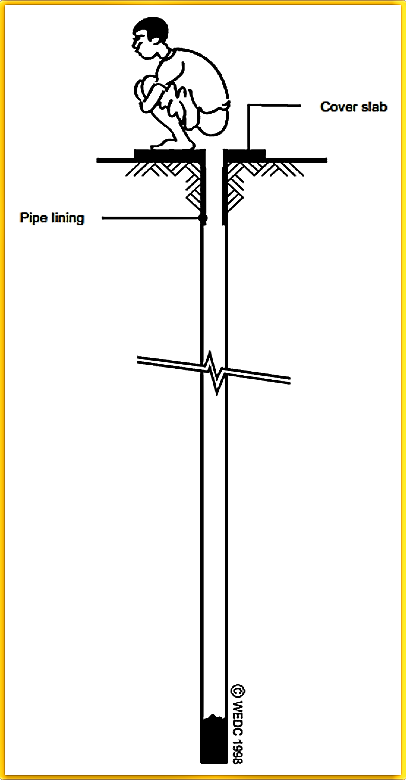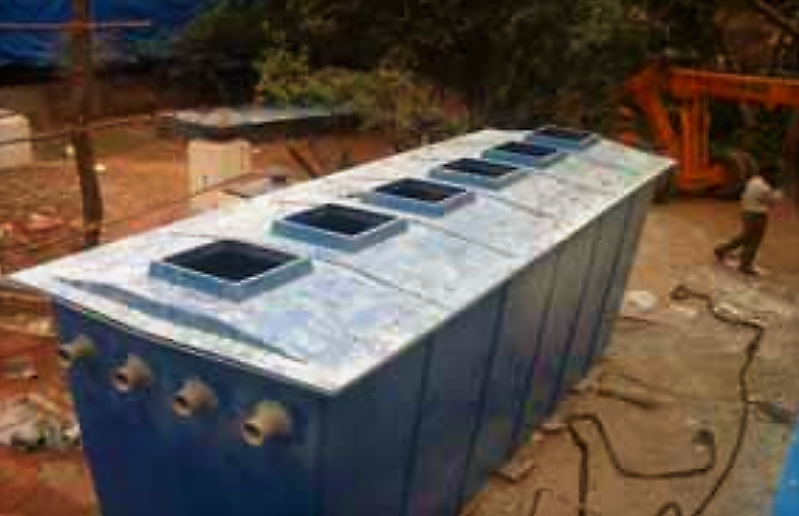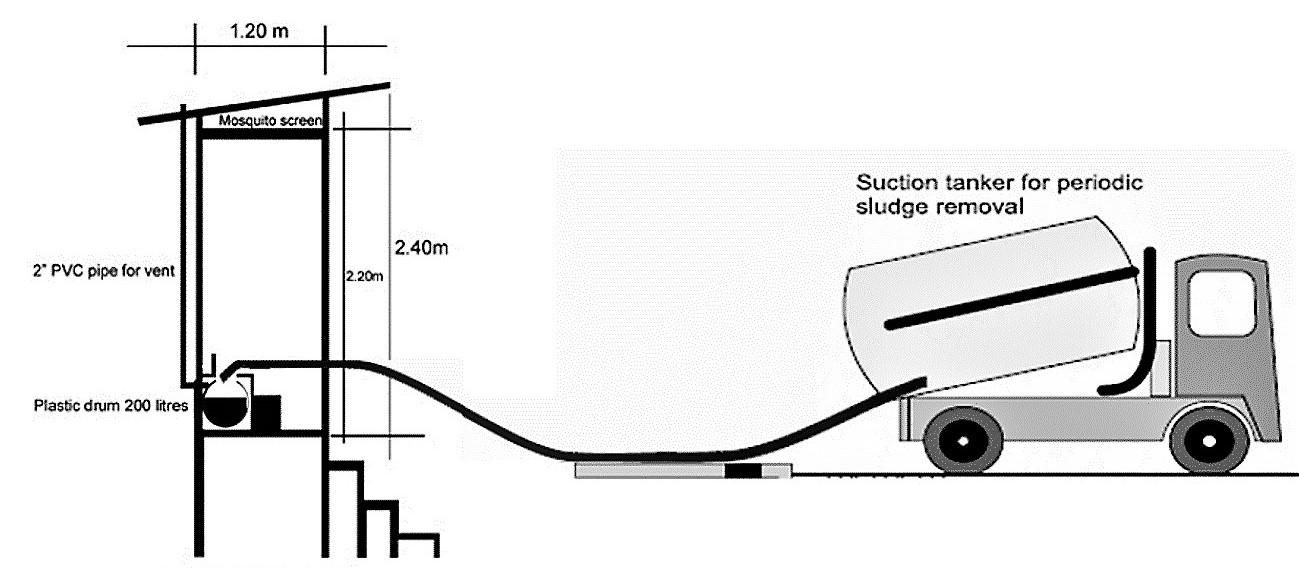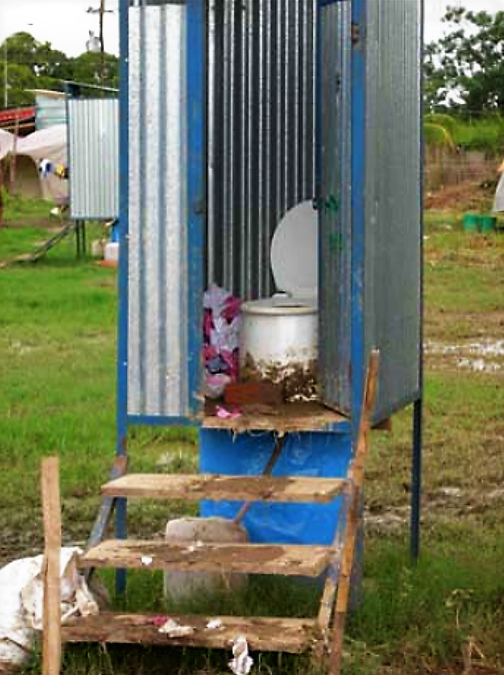Safe excreta disposal is a high priority task in emergencies. The choice of the optimal sanitation facility depends on different factors such as the context, the process from planning to implementation, and the emergency phase. While the immediate response focuses on the collection and confinement of the excreta, the medium-term response focuses on the treatment and management of the sludge as well as greywater, solid waste and stormwater. Sanitation systems are continuously being improved step-by-step.
Emergency interventions aim to provide basic facilities to contain and separate excreta, and to prevent transmission of faecal-oral diseases and the contamination of water sources (see sanitation in emergencies). The medium- and long-term phase of an emergency response follows the immediate emergency phase and typically lasts from several months to several years in complex emergencies. It covers the time where the situation becomes stabilised and more sustainable interventions can be implemented for longer-term use. Community structures may reassemble and morbidity and mortality rates should start to fall. However, emergency situations do not follow a linear progression: some situations may become more acute after improvements, e.g. when the affected population increases, an epidemic occurs, or the security deteriorates (HARVEY 2007).
While the immediate response focuses on the collection and confinement of the excreta, the medium-term response focuses on the treatment and management of the sludge as well as greywater, solid waste and stormwater. All wastewater treatment systems in emergencies produce sludge – either continuously or intermittently. This sludge requires careful handling and disposal in a pit, an incinerator or on agricultural land.
Emergency preparedness planning should include identification of suitable sites for the safe disposal of sanitary wastes, such as sewage and faecal wastes from latrines (GLOBAL WASH LEARNING PROJECT 2008).
| Stabilisation emergency phase (short-term interventions) | Recovery emergency phase (medium-term and long-term interventions) | |
| Priorities | Promoting use and organising people to operate and maintain toilets | Longer term use; developing to higher standards / technology |
| Stakeholder involvement | Community & household level | Household level |
| Technology choice | Pit latrines, managed by community or households, borehole latrine | Simple pit latrines, VIPs,UDDTs, composting toilets, terra preta toilets, fossa alterna, arborloo, pour-flush toilets, borehole latrines, septic tanks and anaerobic baffled reactors, biogas settlers, horizontal constructed wetlands etc. (see also wastewater treatments)Priorities, stakeholder involvement and technology choice for the sanitation actions in an emergency response after the immediate emergency phase. |
Priorities, stakeholder involvement and technology choice for the sanitation actions in an emergency response after the immediate emergency phase. Adapted from JOHANNESSEN & BIKABA 2009
While certain emergency phases can be defined, the choice of the actual sanitation system for each phase depends on the particular situation e.g. if people live scattered or in a camp, if they are in an in-situ or an ex-situ situation (see also sanitation in emergencies), in urban or rural areas, and the specific needs related to sanitation.
Simple pit latrines are by far the most common technology choice adopted in emergency situations. They should be designed as deep as possible (at least 2m) and covered by a slab (e.g. concrete, wood or prefabricated plastic) with a removable lid in order to prevent odour and flies. Ventilated improved pit latrines are designed to minimise odour and flies and do not require water for functioning. Due to their higher costs they are generally exclusively affordable for institutions (e.g. schools and hospitals) during emergencies (HARVEY 2007). When pits are filled, they are usually covered with 1 to 1.5 metres of soil and left for decomposition and a new pit has to be dug out. Diversion of urine prevents excreta collection chambers to fill up too quickly and also limits the risks of groundwater pollution by reducing the infiltration of contaminated liquid into the ground (see also urine diversion toilets and urine diversion components).

Borehole latrines can be constructed very rapidly in a deep soil profile if drilling equipment is available (5 to 10m deep, depending on the groundwater table). But there is a greater risk of groundwater pollution and higher probability of blockages compared to pit latrines. Borehole latrines should be considered only if pit excavation is impossible (HARVEY 2007).

Peepoo bags have been used as a medium-term emergency response, e.g. in Haiti by Oxfam. If collection and safe disposal are provided, this is an efficient way of maintaining hygienic conditions while minimising the risk of environmental pollution.
Ecological toilets (such as urine diversion toilets, composting toilets, terra preta toilets, twin pits pour-flush toilet) also have the advantage of being “dry” and therefore suited for areas with a high risk of groundwater pollution through infiltration of leakage from pits. From a long-term perspective, these solutions also offer the option of using products for gardening and agriculture (see also urine fertilisation or use of compost). However, ecological systems require the user being instructed on how to use them and maintenance is generally slightly higher.
Where users are not used to dry-toilet systems and water is used for the cleansing, pour flush toilets can be implemented. However, they are more expensive than pit latrines and require water. Moreover they have to be connected to collection tanks (e.g. septic tanks; biogas settler or anaerobic baffled reactor), which require frequent desludging as well as transport (see also motorised and human-powered emptying and transport) and further treatment of the sludge.

Package wastewater treatment plants such as Rotating Biological Contactors (RBCs) or activated sludge processes are quick to install, highly automated and provide an effective barrier against pathogens. The disadvantages include the high costs, high energy consumption, and that they are basically not designed to treat the highly concentrated waste arising from emergency settlements as this may inhibit their performance (HARVEY 2007). Also skilled staff is required for maintenance and spare parts are often barely available locally.

If the emergency situation persists or a displaced population is not expected to return to their homes after a couple of months, a longer-term solution has to be found. For long-term solutions, the same criteria apply as for a non-emergency sanitation system (see also sanitation system).
Excreta from dry sanitation systems can be composted and reused (see also reuse of compost). Arborloos and fossa alterna systems allow for direct on-site reuse of the composted excreta. Faeces from urine diversion toilets can be dehydrated before composting and/ or reuse. Urine can be stored and then applied as fertiliser in agriculture (see also storage of urine and urine fertilisation at small-scale).
Sludge from wet systems (e.g. septic tanks) has to be emptied and transported either manually or by trucks or a sewer system (see PPT) has to be installed. Sludge treatments include small scale and large scale composting, anaerobic digestion, drying beds, settling ponds followed by use of compost, small and large scale incineration or disposal in landfills.
Besides excreta collection and treatment, sanitation also includes the management of greywater. There are options for directly reusing greywater relatively easily (see also vertical gardens and greywater towers). If greywater has to be disposed of, a managed infiltration system needs to be constructed (see also leach field, soak pit or evapotranspiration bed).
Moreover, solid waste has to be managed to maintain proper hygiene conditions. Organic solid waste can be composted (see also large scale composting) or used for the production of biogas (see also anaerobic digestion of organic solid waste). Other waste should be incinerated (see also small and large scale incineration) and finally disposed of safely in landfills.
Finally, the management of surface run-off is often forgotten in sanitation; read more in stormwater management.
Following the flooding of the Rio Beni in Bolivia in March 2008, approximately 20,000 people moved to higher grounds where open defecation presented a health risk. Sanitation units were installed as quickly as possible. Urine diversion toilets were installed and faeces were collected in 200 litre drums and urine was drained into containers for disposal. The faeces were collected each day and transported by truck to a landfill site. One problem that was experienced was with disposal of toilet paper. In Bolivia, people use to throw their used toilet paper into a bin next to the toilet. If no bin is provided, the used toilet paper gets thrown on the floor beside the toilet. For communal toilets, this caused both a hygiene risk and a littering problem (OXFAM 2009).

EmSan - Emergency Sanitation
This source presents the DEWATS emergency sanitation service package, including options for different types of prefabricated materials, developed by BORDA.
BORDA (2009): EmSan - Emergency Sanitation. An innovative & rapidly installable solution to improve hygiene and health in emergency situations. (= Concept Note ). Bremen: Bremen Overseas Research and Development Association URL [Accessed: 31.05.2019]Lessons Learned in WASH Response During Urban Flood Emergencies
This paper identifies various lessons that can be learned from urban flood emergencies, with a focus on the WASH sector. It includes urban flood management issues in emergencies related to water, sanitation, hygiene and various crosscutting issues.
GLOBAL WASH LEARNING PROJECT (2008): Lessons Learned in WASH Response During Urban Flood Emergencies. New York: Global WASH Cluster URL [Accessed: 23.04.2012]Emergency Sanitation: Assessment and Programme Design
This book has been written to help all those involved in planning and implementing emergency sanitation programmes. The main focus is a systematic and structured approach to assessment and programme design. There is a strong emphasis on socio-cultural issues and community participation throughout.Includes an extensive “guidelines” section with rapid assessment instructions and details on programme design, planning and implementation.
HARVEY, P. BAGHRI, S. REED, B. (2002): Emergency Sanitation: Assessment and Programme Design. Loughborough: Water, Engineering and Development Centre (WEDC) URL [Accessed: 31.05.2019]Excreta Disposal in Emergencies. A Field Manual
In this manual existing, innovative and new technologies and approaches for excreta disposal in emergency situations are investigated. It provides practical guidance on how to select, design, construct and maintain appropriate excreta disposal systems to reduce faecal transmission risks and protect public health in emergency situations.
HARVEY, P.A. (2007): Excreta Disposal in Emergencies. A Field Manual. Leicestershire: WEDC Loughborough University URL [Accessed: 29.07.2011]Sustainable Sanitation for Emergencies and Reconstruction Situations - Factsheet of Working Group 8 (draft)
This well structured and informative factsheet from the SuSanA network deals with the planning of sustainable sanitation for emergencies and reconstruction situations in low- and middle-income countries.
JOHANNESSEN, A. BIKABA, D. (2009): Sustainable Sanitation for Emergencies and Reconstruction Situations - Factsheet of Working Group 8 (draft). Eschborn: Sustainable Sanitation Alliance SuSanA URL [Accessed: 23.04.2012]Identifying Gaps in Emergency Sanitation. Design of New Kits to Increase Effectiveness in Emergencies
UD Toilets and Composting Toilets in Emergency Settings
Vulnerability and Socio-Cultural Considerations for PHE in Emergencies. Oxfam Technical Brief
This technical note points out the importance of including the needs of vulnerable groups into public health programmes in general. It features a checklist for practically responding to gender and other socio-cultural issues and a case study from Pakistan (2005) where Oxfam adapted communal sanitation facilities for communities where women previously lived in seclusion.
OXFAM (n.y): Vulnerability and Socio-Cultural Considerations for PHE in Emergencies. Oxfam Technical Brief. Oxford: OXFAM URL [Accessed: 09.06.2019]Philippine Emergency Sanitation Reference Toolkit. Excreta Disposal
This toolkit is a compilation of existing relevant sanitation focused emergency response mechanisms, technologies and experiences to support institutions and local government units in disaster response. It was developed in the aftermath of cyclone Ketsana in 2009.
PEN (2010): Philippine Emergency Sanitation Reference Toolkit. Excreta Disposal. Manila: The Philippine Ecosan Network (PEN)Compendium of Sanitation Systems and Technologies (Arabic)
This is the Arabic version of the Compendium of Sanitation Systems and Technologies. The Compendium gives a systematic overview on different sanitation systems and technologies and describes a wide range of available low-cost sanitation technologies.
TILLEY, E. ULRICH, L. LUETHI, C. REYMOND, P. SCHERTENLEIB, R. ZURBRUEGG, C. (2014): Compendium of Sanitation Systems and Technologies (Arabic). 2nd Revised Edition. Duebendorf, Switzerland: Swiss Federal Institute of Aquatic Science and Technology (Eawag) PDFSanitation Systems and Technologies. Lecture Notes
Lecture notes on technical and non-technical aspects of sanitation systems in developing countries.
EAWAG/SANDEC (2008): Sanitation Systems and Technologies. Lecture Notes . (= Sandec Training Tool 1.0, Module 4 ). Duebendorf: Swiss Federal Institute of Aquatic Science (EAWAG), Department of Water and Sanitation in Developing Countries (SANDEC)Excreta Disposal in Emergencies. A Field Manual
In this manual existing, innovative and new technologies and approaches for excreta disposal in emergency situations are investigated. It provides practical guidance on how to select, design, construct and maintain appropriate excreta disposal systems to reduce faecal transmission risks and protect public health in emergency situations.
HARVEY, P.A. (2007): Excreta Disposal in Emergencies. A Field Manual. Leicestershire: WEDC Loughborough University URL [Accessed: 29.07.2011]Sustainable Sanitation for Emergencies and Reconstruction Situations - Factsheet of Working Group 8 (draft)
This well structured and informative factsheet from the SuSanA network deals with the planning of sustainable sanitation for emergencies and reconstruction situations in low- and middle-income countries.
JOHANNESSEN, A. BIKABA, D. (2009): Sustainable Sanitation for Emergencies and Reconstruction Situations - Factsheet of Working Group 8 (draft). Eschborn: Sustainable Sanitation Alliance SuSanA URL [Accessed: 23.04.2012]Guidelines for Excreta Disposal in Emergencies. An Oxfam Technical Manual
These guidelines give technical managers of excreta disposal in emergencies practical assistance in planning and implementing such programmes. The document includes a standard logical framework, and many technical details.
OXFAM (2000): Guidelines for Excreta Disposal in Emergencies. An Oxfam Technical Manual. Oxford: OXFAM URL [Accessed: 02.08.2011]Emergency Field Handbook
This handbook has been developed as a practical tool to meet the needs of children and women affected by disasters. It is a very detailed document where a lot of information can be found by practioneers around the globe.
UNICEF (2005): Emergency Field Handbook. A Guide for UNICEF Staff. New York: The United Nations Children's Fund (UNICEF) URL [Accessed: 09.06.2019]Solid Waste Management in Emergencies
The safe disposal of solid waste is critical for public health, and is especially true during an emergency. If solid waste is not dealt with quickly, serious health risks will develop which will further demoralize the community already traumatized by the emergency. This technical note highlights the key issues to consider in managing solid waste during and shortly after a disaster.
ROUSE, J. REED, B. (2013): Solid Waste Management in Emergencies. (= Technical Notes on Drinking-Water, Sanitation and Hygiene in Emergencies , 7 ). Geneva: World Health Organization (WHO) URL [Accessed: 27.08.2013]Environmental Health in Emergencies and Disasters. Chapter 7: Water Supply
Contains all necessary information related to water needs, quality, testing, catchment, treatment, storage and distribution in emergencies, as well as health related issues. Well structured, not too long, good illustrations and graphics.
WISNER, B. ; ADAMS, J. (2002): Environmental Health in Emergencies and Disasters. Chapter 7: Water Supply. A Practical Guide. Geneva: World Health Organization (WHO) URL [Accessed: 21.05.2019]Technical Notes on Drinking-Water, Sanitation and Hygiene in Emergencies
These technical notes are relevant to a wide range of emergency situations, including both natural and conflict-induced disasters. They are suitable for field technicians, engineers and hygiene promoters, as well as staff from agency headquarters.
WHO ; WEDC (2013): Technical Notes on Drinking-Water, Sanitation and Hygiene in Emergencies. Geneva: World Health Organization (WHO) URL [Accessed: 27.08.2013]Water, Sanitation and Hygiene (WASH) in Health-Care Facilities in Emergencies
Health-care facilities play a vital role within the community by providing essential medical care at all times including during emergencies. Any incident which causes loss of infrastructure, energy supply, loss of equipment, loss of staff or staff attrition, interruption to supply chains, or patient surge - such as sudden communicable disease epidemics, natural disasters (e.g. floods, earthquakes), or conflict - requires a holistic health response and recovery effort which includes actions to assess and restore basic WASH services.
HARVEY, B. (2012): Water, Sanitation and Hygiene (WASH) in Health-Care Facilities in Emergencies. Technical Notes on Drinking-water, Sanitation and Hygiene in Emergencies. (= Technical Notes on Drinking-Water, Sanitation and Hygiene in Emergencies. [Accessed: 30.09.2013] , 17 ). Geneva: World Health Organization (WHO) PDFFaecal Sludge Management
Household UDDTs after cyclone disaster, Padma and Rohitra villages, Barishal Division, Bangladesh Case study of sustainable sanitation projects
This case study presents a post-rehabilitation project in Bangladesh after cyclone Sidr in 2007, which included provision of 100 twin vault UDDTs in rural villages. The three main challenges were finding an adequate place on the compound for the UDDTs, the use of UDDTs e.g. daily practices and maintenance, and the reuse of dried excreta.
DELEPIERE, A. (2011): Household UDDTs after cyclone disaster, Padma and Rohitra villages, Barishal Division, Bangladesh Case study of sustainable sanitation projects. Sustainable Sanitation Alliance (SuSanA) URL [Accessed: 09.06.2019]Lessons Learned in WASH Response During Urban Flood Emergencies
This paper identifies various lessons that can be learned from urban flood emergencies, with a focus on the WASH sector. It includes urban flood management issues in emergencies related to water, sanitation, hygiene and various crosscutting issues.
GLOBAL WASH LEARNING PROJECT (2008): Lessons Learned in WASH Response During Urban Flood Emergencies. New York: Global WASH Cluster URL [Accessed: 23.04.2012]Sanitation in an Afghan Refugee Camp. Design for a Community Approach Programme
This brief paper describes project design for the delivery of 6’000 family pit latrines in an Afghan refugee camp within a few months. For the superstructure a small hut made of mud blocks was chosen due to the climate conditions with extremely hot summers and winter frosts.
HEINZ, C. (1996): Sanitation in an Afghan Refugee Camp. Design for a Community Approach Programme. In: AT Forum 7, p.96. [Accessed: 02.08.2011]: PDFDelivering Water, Sanitation and Hygiene Services in an Uncertain Environment: Thermophilic Composting of Human Wastes in Uncertain Urban Environments
This paper describes the project of constructing a thermophilic composting site in Haiti after the earthquake in 2010. The composting facilities have treated over 500,000 gallons of human waste in the past three years, converting it to pathogen free compost, over 10,000 gallons of which has been sold for use in agriculture and reforestation projects. The experience of thermophilic composting in Haiti is unique in scale and duration and can have global implications for waste treatment in both emergency and development contexts.
KRAMER, S. PRENETA, N. KILBRIDE, A. (2013): Delivering Water, Sanitation and Hygiene Services in an Uncertain Environment: Thermophilic Composting of Human Wastes in Uncertain Urban Environments. A Case Study from Haiti. (= WECD International Conference , 36 ). Oakland: Sustainable Organic Integrated Livelihoods (SOIL) URL [Accessed: 01.06.2019]Delivering Water, Sanitation and Hygiene Services in an Uncertain Environment: Piloting Ecological Sanitation (EcoSan) in the Emergency Context of Port-au-Prince, Haiti, after the 2010 Earthquake
The earthquake that struck Haiti in January 2010 and the cholera epidemic that followed from October 2010, resulted in one of the largest humanitarian relief efforts in history. Many of the internally displaced persons camps were located in urban neighbourhoods with high groundwater, making onsite sanitation extremely difficult. In response to these unique conditions a small local organization, SOIL, partnered with Oxfam Great Britain to pilot urine diversion EcoSan toilets in camps throughout Port-au-Prince. This briefing paper covers this pilot project from March 2010 through March 2012. During that 2-year period, SOIL’s toilets served over 20,000 people and treated more than 400,000 gallons of human waste, converting it to rich compost.
KILBRIDE, A. KRAMER, S. PRENETA, N. (2013): Delivering Water, Sanitation and Hygiene Services in an Uncertain Environment: Piloting Ecological Sanitation (EcoSan) in the Emergency Context of Port-au-Prince, Haiti, after the 2010 Earthquake. (= WECD International Conference , 36 ). Oakland: Sustainable Organic Integrated Livelihoods (SOIL) URL [Accessed: 01.06.2019]Emergency Sanitation: Assessment and Programme Design
This book has been written to help all those involved in planning and implementing emergency sanitation programmes. The main focus is a systematic and structured approach to assessment and programme design. There is a strong emphasis on socio-cultural issues and community participation throughout.Includes an extensive “guidelines” section with rapid assessment instructions and details on programme design, planning and implementation.
HARVEY, P. BAGHRI, S. REED, B. (2002): Emergency Sanitation: Assessment and Programme Design. Loughborough: Water, Engineering and Development Centre (WEDC) URL [Accessed: 31.05.2019]Planning for Excreta Disposal in Emergencies
The pressure to help people immediately after a disaster often leads to actions starting before they have been properly planned. This Technical Note is a guide to the planning process of excreta disposal during the first two phases of an emergency. Technical options are presented in Technical Note 14.
REED, B. (2013): Planning for Excreta Disposal in Emergencies. (= Technical Notes on Drinking-Water, Sanitation and Hygiene in Emergencies , 13 ). Geneva: World Health Organization (WHO) URL [Accessed: 01.10.2013]Technical Options for Excreta Disposal in Emergencies. Technical Notes on Drinking-Water, Sanitation and Hygiene in Emergencies
Initially, indiscriminate defecation is usually the main health hazard in refugee camps. This technical note outlines ways in which excreta and urine can be managed during the early stages of an emergency, while long-term solutions are devised.
REED, B. (2013): Technical Options for Excreta Disposal in Emergencies. Technical Notes on Drinking-Water, Sanitation and Hygiene in Emergencies. (= Technical Notes on Drinking-Water, Sanitation and Hygiene in Emergencies , 14 ). Geneva: World Health Organization (WHO) URL [Accessed: 01.10.2013]Ecological Sanitation in the Earthquake Area
This presentation includes some pictures of insufficient latrines used after an Asian earthquake in 2008.
GAO, J. (2008): Ecological Sanitation in the Earthquake Area. Clean Water Alliances URL [Accessed: 12.03.2012]Vulnerability and Socio-Cultural Considerations for PHE in Emergencies. Oxfam Technical Brief
This technical note points out the importance of including the needs of vulnerable groups into public health programmes in general. It features a checklist for practically responding to gender and other socio-cultural issues and a case study from Pakistan (2005) where Oxfam adapted communal sanitation facilities for communities where women previously lived in seclusion.
OXFAM (n.y): Vulnerability and Socio-Cultural Considerations for PHE in Emergencies. Oxfam Technical Brief. Oxford: OXFAM URL [Accessed: 09.06.2019]Handbook for Emergencies. Third Edition
This extensive handbook from the UN High Commissioner for Refugees (UNHCR) on emergency responses reflects the multiple dimensions of an emergency response, ranging from emergency management to emergency operations and their support. The handbook mainly looks at emergencies where populations have been displaced from their former living environment.
UNHCR (2007): Handbook for Emergencies. Third Edition. Geneva: UNHCR Emergency Preparedness and Response Section URL [Accessed: 21.05.2019]SuSanA Working Groups
The objective of this SuSanA working group is to combine the knowledge from experts in the fields of sanitation with the knowledge from experts in the field of emergency response and reconstruction. The site includes documents, workshop inputs and presentations with best practice examples of sustainable sanitation options in emergency and reconstruction situations.
Water, sanitation & hygiene (WASH)
The UNEP Resource Centre for Mainstreaming Environment into Humanitarian Responses provides an overview of various sources related to WASH emergency responses – trying to emphasise the role of environment in WASH emergency responses.
WatSan Mission Assistant
This site has a wealth of resources for water, sanitation and hygiene (WASH) practitioners collected by the International Federation of Red Cross and Red Crescent Societies (IFRC) with a focus on emergency situations.

